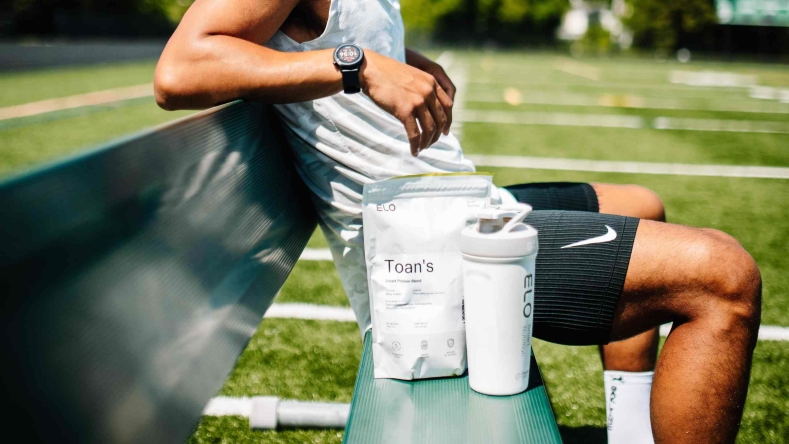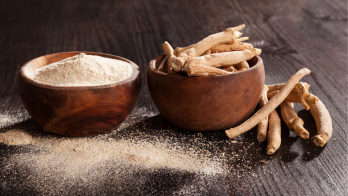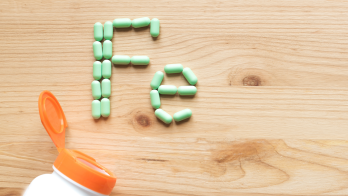How to increase protein intake for endurance athletes
When it comes to optimizing body composition, endurance, and recovery times, there’s one macronutrient that seems to do it all. Whether you’re a runner, cyclist, or triathlete, here’s how to increase protein intake to level up your endurance game.

Endurance athletes rely on a precise balance of nutrition and training to achieve peak performance. And while carbohydrates
This article explores the health benefits of protein for endurance athletes and uncovers the differences between pea protein vs. whey protein. We will also share ideas for how to increase protein intake to further boost performance and recovery.
So, tie up your running shoes and strap on your helmet – it’s time to dive into the world of protein for endurance athletes.
Benefits of protein for endurance athletes
Protein is crucial for endurance athletes due to its multifaceted role in promoting optimal performance and recovery, including the repair and growth of muscle tissue.
Endurance activities (such as long-distance running or cycling) place significant stress on the muscles, leading to micro-tears and cellular damage. As such, it’s important to consume adequate amounts of protein to help repair this damage and maintain muscle mass, prevent injury and promote overall strength. Here are a few other benefits that protein has for endurance athletes.
Improved endurance: Studies have found that protein intake - especially for endurance athletes - is associated with prolonged periods of increased muscle protein synthesis (MPS), which may help enhance endurance over time [
1
].Reduced muscle damage. Research indicates that supplemental protein can reduce muscle soreness and markers of muscle damage, especially when taken after daily training sessions [
2
].Enhanced muscle repair and recovery. Protein may help facilitate muscle recovery and function when taken within 24 hours of exercise [
3
].Better body composition. When combined with exercise, a high-protein diet appears to increase muscle growth and fat loss, which can contribute to better body composition [
4
].

Elo Smart Recovery
Elo Smart Recovery
To get your custom blend, we provide a series of questions for you to answer about your dietary habits and preferences, goals, exercise level and frequency, height, weight, age, and gender. Elo AI then matches your information with the latest scientific research to generate a unique blend of protein and wellness boosts (which may include carbohydrates, electrolytes, collagen, amino acids, probiotics, turmeric, ashwagandha, multivitamin, and/or supergreens) just for you.
With over 10,000 possible combinations of ingredients, Smart Recovery is the most personalized product on the market.
Elo AI also provides specific Smart Recovery dosing recommendations after every workout when you sync your wearable data with the Elo App. Dosage recommendations incorporate factors such as the activity you completed, your body weight, and the leucine content of your mix to help you recover better.
Our best tasting protein powder comes in a variety of offerings (like chocolate protein powder, vanilla whey protein powder, and vegan options), and you’ll get a hefty protein shaker bottle to enjoy it with.
Get your custom recovery blend today!
How much protein do you need for endurance exercise?
Endurance athletes (including long-distance cyclists, runners, and triathletes) need more protein than the average individual because these activities increase your metabolic needs and break down muscle tissue [ 5 6
Due to these increased needs, experts say endurance athletes need anywhere from 1.4 to 2 g/kg/day [ 7
Does protein timing matter?
Studies have found that when you take your protein matters more than you realize. Because your body requires essential amino acids to stimulate MPS, timing your protein intake will help ensure your body has the amino acids it needs to meet the increased metabolic needs of endurance athletes and support athletic performance and recovery.
Here are four ways to optimize your protein timing.
Divide and conquer. Research shows that taking 20 g of whey protein every 3 hours may help to stimulate MPS throughout the day [
8
].Try a pre-workout protein boost. Taking 0.3 g of protein/kg before endurance exercise may help offset markers of muscle damage [
9
].Mix carbs and protein. During longer training sessions or endurance events, try adding 0.25 g of protein/kg/hr to your regular carbohydrate replenishment regimen, as this may reduce muscle damage and soreness [
9
].Don’t skip post-workout fuel. Studies show that consuming 20-40 g of high-quality protein post-exercise can stimulate robust increases in muscle protein synthesis [
10
].

Pea protein vs. whey protein
Protein powder is the most popular type of protein supplement. Made from protein-rich foods (like milk and egg whites) and plant sources (like soy, pea, rice, pumpkin seed, and hemp), protein powder can be a convenient and cost-effective way to get more quality protein in your diet.
While there are many types of protein powders to choose from, here’s the difference between whey protein vs plant protein.
Pea protein
With 15 g of protein/serving, this plant-based protein powder is rich in branched-chain amino acids (BCAAs) and contains arginine and leucine to promote strength, performance, body composition, and muscle thickness [ 11 12 12
At Elo, we offer
plant-based pea protein
that is sourced from non-GMO Belgian yellow peas with no additives or soy.
Whey isolate protein
Whey is one of the primary proteins found in dairy and contains all of the essential amino acids. It’s also highly digestible and quickly absorbed, all while packing about 25 g of protein/serving. Furthermore, whey protein is rich in leucine (which helps kick-start muscle repair and growth), making it a top choice among gym-goers and athletes [ 13
Here are some additional benefits of whey protein.
Mitigate muscle damage. Studies show that people who had a high intake of whey protein for 5 days (post-exercise) had mitigated muscle damage biomarkers compared to those who didn’t have whey protein [
14
].Lower blood pressure. Research has found that whey protein may help lower blood pressure in pre-hypertensive adults [
15
].More stable blood sugar levels. Whey protein can be helpful in moderating glucose levels, as one study found that people who consumed whey protein with their meals experienced a 28% decrease in blood sugar levels [
16
].Lower cholesterol levels. Whey protein may support heart health, as research has found that high doses of whey protein can help reduce cholesterol levels over time [
17
].
At Elo, we offer
grass-fed whey protein
, which is sourced from pasture-raised cows never treated with hormones or antibiotics.
How many protein shakes a day?
How many protein shakes you need each day depends on your protein needs, which can vary based on age, activity levels, and gender. However, protein shakes are meant to help bridge the gap for any nutrient deficiencies in your diet and should not replace high-quality protein foods.
How to increase protein intake after exercise
Getting enough protein may seem challenging, but it doesn’t have to be. Here are some ways for how to increase protein intake post-workout.
Vegan protein shake made with pea protein powder and plant milk of choice
Eggs
Dairy
Lean meat
Poultry
Fish
Beans
Lentils
Peas
Soybeans
Tofu
Want to incorporate more of these foods into your diet? Check out these delicious high-protein meals and snacks for active people
Summary
Protein plays a key role in body composition, endurance, and recovery, which means that it should be prioritized before, during, and after training sessions. You can optimize your protein intake and boost performance by focusing on protein quality, nutrient timing, and eating a balanced diet throughout the day.
While you can meet your protein needs with dietary sources like lean meats, eggs, beans, and lentils, protein supplements (like Elo Smart Recovery
Disclaimer: The text, images, videos, and other media on this page are provided for informational purposes only and are not intended to treat, diagnose, or replace personalized medical care.
Key takeaways
Experts say endurance athletes need anywhere from 1.4 to 2 g/kg/day [
7
].Timing your protein intake will help ensure your body has the amino acids it needs to meet the increased metabolic needs and support athletic performance and recovery.
Personalized protein supplements, like
Elo Smart Recovery
, can help endurance athletes meet their unique protein and nutritional needs.
References
Knuiman, P., Hopman, M. T. E., Verbruggen, C., & Mensink, M. (2018). Protein and the Adaptive Response With Endurance Training: Wishful Thinking or a Competitive Edge?. Frontiers in physiology, 9, 598.
https://doi.org/10.3389/fphys.2018.00598
Pasiakos, S. M., Lieberman, H. R., & McLellan, T. M. (2014). Effects of protein supplements on muscle damage, soreness and recovery of muscle function and physical performance: A systematic review. Sports Medicine, 44(5), 655–670.
https://doi.org/10.1007/s40279-013-0137-7
Ives, S. J., Bloom, S., Matias, A., Morrow, N., Martins, N., Roh, Y., Ebenstein, D., O’Brien, G., Escudero, D., Brito, K., Glickman, L., Connelly, S., & Arciero, P. J. (2017). Effects of a combined protein and antioxidant supplement on recovery of muscle function and soreness following eccentric exercise. Journal of the International Society of Sports Nutrition, 14(1).
https://doi.org/10.1186/s12970-017-0179-6
Antonio, J., Candow, D. G., Forbes, S. C., Ormsbee, M. J., Saracino, P. G., & Roberts, J. (2020). Effects of Dietary Protein on Body Composition in Exercising Individuals. Nutrients, 12(6), 1890.
https://doi.org/10.3390/nu12061890
Kato, H., Suzuki, K., Bannai, M., & Moore, D. R. (2016). Protein requirements are elevated in endurance athletes after exercise as determined by the indicator amino acid oxidation method. PLOS ONE, 11(6).
https://doi.org/10.1371/journal.pone.0157406
Pasiakos, S. M., McLellan, T. M., & Lieberman, H. R. (2014). The effects of protein supplements on muscle mass, strength, and aerobic and anaerobic power in healthy adults: A systematic review. Sports Medicine, 45(1), 111–131.
https://doi.org/10.1007/s40279-014-0242-2
Campbell, B., Kreider, R. B., Ziegenfuss, T., La Bounty, P., Roberts, M., Burke, D., Landis, J., Lopez, H., & Antonio, J. (2007). International Society of Sports Nutrition Position Stand: Protein and exercise. Journal of the International Society of Sports Nutrition, 4(1).
https://doi.org/10.1186/1550-2783-4-8
Areta, J. L., Burke, L. M., Ross, M. L., Camera, D. M., West, D. W., Broad, E. M., Jeacocke, N. A., Moore, D. R., Stellingwerff, T., Phillips, S. M., Hawley, J. A., & Coffey, V. G. (2013). Timing and distribution of protein ingestion during prolonged recovery from resistance exercise alters myofibrillar protein synthesis. The Journal of physiology, 591(9), 2319–2331.
https://doi.org/10.1113/jphysiol.2012.244897
Vitale, K., & Getzin, A. (2019). Nutrition and supplement update for the endurance athlete: Review and recommendations. Nutrients, 11(6), 1289.
https://doi.org/10.3390/nu11061289
Patel, K., & Examine.com. (2023, January 31). How much protein do you need after exercise?. Examine.
https://examine.com/articles/second-look-at-protein-quantity-after-exercise/
Banaszek, A., Townsend, J. R., Bender, D., Vantrease, W. C., Marshall, A. C., & Johnson, K. D. (2019). The Effects of Whey vs. Pea Protein on Physical Adaptations Following 8-Weeks of High-Intensity Functional Training (HIFT): A Pilot Study. Sports (Basel, Switzerland), 7(1), 12.
https://doi.org/10.3390/sports7010012
Babault, N., Païzis, C., Deley, G., Guérin-Deremaux, L., Saniez, M. H., Lefranc-Millot, C., & Allaert, F. A. (2015). Pea proteins oral supplementation promotes muscle thickness gains during resistance training: a double-blind, randomized, Placebo-controlled clinical trial vs. Whey protein. Journal of the International Society of Sports Nutrition, 12(1), 3.
https://doi.org/10.1186/s12970-014-0064-5
Waskiw-Ford, M., Hannaian, S., Duncan, J., Kato, H., Abou Sawan, S., Locke, M., Kumbhare, D., & Moore, D. (2020). Leucine-Enriched Essential Amino Acids Improve Recovery from Post-Exercise Muscle Damage Independent of Increases in Integrated Myofibrillar Protein Synthesis in Young Men. Nutrients, 12(4), 1061.
https://doi.org/10.3390/nu12041061
Nieman, D. C., Zwetsloot, K. A., Simonson, A. J., Hoyle, A. T., Wang, X., Nelson, H. K., Lefranc-Millot, C., & Guérin-Deremaux, L. (2020). Effects of whey and pea protein supplementation on post-eccentric exercise muscle damage: A randomized trial. Nutrients, 12(8), 2382.
https://doi.org/10.3390/nu12082382
Yang, J., Wang, H. P., Tong, X., Li, Z. N., Xu, J. Y., Zhou, L., Zhou, B. Y., & Qin, L. Q. (2019). Effect of whey protein on blood pressure in pre- and mildly hypertensive adults: A randomized controlled study. Food science & nutrition, 7(5), 1857–1864.
https://doi.org/10.1002/fsn3.1040
Jakubowicz, D., Froy, O., Ahrén, B., Boaz, M., Landau, Z., Bar-Dayan, Y., Ganz, T., Barnea, M., & Wainstein, J. (2014). Incretin, insulinotropic and glucose-lowering effects of whey protein pre-load in type 2 diabetes: A randomised clinical trial. Diabetologia, 57(9), 1807–1811.
https://doi.org/10.1007/s00125-014-3305-x
Amirani, E., Milajerdi, A., Reiner, Ž., Mirzaei, H., Mansournia, M. A., & Asemi, Z. (2020). Effects of whey protein on glycemic control and serum lipoproteins in patients with metabolic syndrome and related conditions: A systematic review and meta-analysis of randomized controlled clinical trials. Lipids in Health and Disease, 19(1).
https://doi.org/10.1186/s12944-020-01384-7







